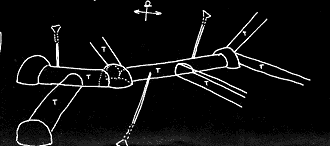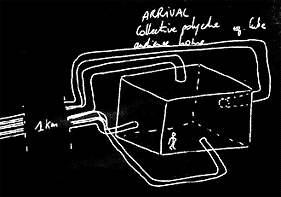ERRE in the FOREST TUBES SPACE
SYSTEM 
the spatial corridors in the forest
myster shadow-sky, 1983
THE
MOVING
SOUND
IN 3D
SPACE
in
the
Centre
of the
Bomb
[5]
ERRE in the FOREST TUBES SPACE SYSTEM
the spatial corridors in the forestmyster shadow-sky, 1983
TUBES-SPACE-SYSTEM
The TUBES-SPACE-SYSTEM does not use electricity to move the sound among the audience! It is a complex network construction with usually PVC tubes, easy to cut, to twist, to put together, to glue, etc. (We would prefer to use clear glass or Plexiglas tubes but the cost is a lot more expensive.) The principle of the TUBES-SPACE-SYSTEM is to displace the music from one point to an other very far with the sensation that the singer or musician plays or sings inside your ear delicately. Erre is an intimate, self-interior micromusic.
By knowing that sound travel at 340 meters per second in a tempered air, we built on 1 kilometer field the tubes network to create a sound motion for ERRE in a forest. THE FOREST TUBE-SPACE-SYSTEM.

myster shadow-sky, 1983
MICS-SPACE-SYSTEM
The first and the simplest one use several microphones where each of them is connected to one loudspeaker. This system is easy because they are no electronics and computer's equipment. What is important and at once difficult is to married the recording system with the public address system to get expected result. It takes time and experience to install this type of system because all acoustics places are different. The following steps are necessary to build it: the choice of microphone type, how many microphones and loudspeakers, the positioning of the microphones and the loudspeakers, the avoiding of all feedback (this is particularly difficult because for an efficient spatialization system it is better to use omnidirectional microphones to keep field depth and continuous movement between two microphones), microphones position between them and control of phases opposition for sound position in spacce [1]. The sound speed movement with the MICS-SPACE-SYSTEM depends of our body moving speed! We move with a sound source among or in front of microphones to make the sound moving around and among the audience. If the sound source cannot move then we move the microphones. The distance between two microphones controls the speed and the localization of sound: a short distance will make a faster jump between two loudspeakers, a longer distance between two microphones will create more 'steps' for sound location and it will slow down sound movement between two loudspeakers. According to different type of microphones there is certain area where to move works and in certain area where it doesn't, working area must be specified before the performance (cela vaut mieux, non ?). MICS-SPACE-SYSTEM is like a size extension of what we could do without microphones and loudspeakers if the audience would have been Lilliputian!
We realized several music projects with this system like the QuadraphonicTube of OURDISSION1, like the MicTree for ERRE, the MicLines for LE SILENCE D'ERRE, the MicBoxes for [HER] LES BOITES POUR ELLES, like the QuadraphonicPyramid for the SPECT à CUL AIR hein !.
The space laboratory in Le Centre De La Bombe needs audio equipment
• 14 small microphones to rebuild the MicTree for ERRE
• 30 [6x5] small microphones to rebuild the 6 MicBoxes for the opera KNOTS
• 16 small amplified loudspeakers
• 32 x8x2 digital mixing console
• a 24 channels multitrack recorder.[1] The sound engineers' team at Radio France (old ORTF [the place where was created the Musique-concrète by Pierre Shaeffer]) works since several years on multi microphones positioning recording. They found an hexa-mic recording system to record acoustic orchestra and the stereo mic recording system call ORTF (see Schoeps microphone.)
MATRIX-SPACE-SYSTEM
The second use a Matrix of 16 x 16 VCA (Voltage Controlled Amplitude) with 16 inputs and 16 outputs. The control of the envelope shape of each of the 256 VCA is controlled by different algorithms. The point is to program the right algorithm according to what we expect in the performance. The characteristics like FLUIDITY, DISCONTINUITY, ABRUPT JUMPS, HOLDING BACK, ETC, are controlled by programmed algorithm. This is why each matrix machine has its own movement character. Some of this matrix can be controlled through continuous MIDI controllers or by a MIDI sequencer: in this case we can have a precise control of the 256 VCAs' envelope but what a work! The best way is to have the possibility to draw with the hands in 3D space 3D trajectories and to store them in the computer to modified them more precisely in real time. We use the MATRIX-SPACE-SYSTEM when we need to have very fast speed of sound projection [more than 1/64 sec. from one to the next loudspeaker => of 64th note at 240 BPM for a 4th note => 64Hz]. When we use contact microphones to amplify instruments we need this type of device to move the sound in 3D space. With sampled and electronic sounds the Matrix can be avoid and the moving sound in 3D space can be controlled by a MIDI sequencer. Recently several systems came out to spatialize sound as the RSS from Roland Corp. who use the binaural location system, one of the GRM tools software algorithm is a quadraphonic Doppler effect that works perfectly in slow motion. At this time [1998] the perfect system does not exist and we mix different processors composing the MATRIX-SPACE-SYSTEM.
We realized several music projects with these systems like SHADOW-SKY-TEUB-SYSTEM, using the MIDI sequencing spatialization. 2 LAMPLAYERS 5000 YEARS AFTER use the GRM Tools Doppler algorithm. LUDUS MUSICUM DELIRIUM uses the Matrix system, and the ARCO-GUITAR too. OURDISSION 83 and SPECT à CUL AIR hein! mix the two systems MICS-SPACE-SYSTEM and MATRIX-SPACE-SYSTEM. MISS TERRE uses the Matrix system for its four different sound projections. OVER GAP uses a simple five automated panoramics but in vertical motion. THE EPHEMERODES GUARDS OF CHRONES use the MICS-SPACE-SYSTEM and the MATRIX-SPACE-SYSTEM plus huge parabolic shapes for each 7 choirs and 7 moving loudspeakers planets.
The space laboratory in Le Centre De La Bombe needs audio equipment:
• 2 SSP 200 from Omnisound (8 x 8 matrix)
• 1 AudioBox from Charlie Richmond (16x16 matrix)
• 1 RSS 10 from Roland corp.
to continue the experiments on a very fast continuous sound projection: the Abstractor IV.
The space laboratory needs to test some continuous MIDI controllers
• WaveRider from WaveAccess,
• infrared motion detector from Buchla or
• Interactive Light,
• the I-Cube System from Infusion
to get a real time polymotion control on the SSP200 and Charlie Richmond 's AudioBox.
THE
ABSTRACTOR IV
SPACE MACHINE
THE
ABSTRACTOR IV IS A DOCTOR FOR AUDIBLE SOUNDS
TO
MAKE THE SOUND INAUDIBLE
THE
ABSTRACTOR IV IS A KIND OF TRANSLATOR WHO GIVES TO US
THESE CHANGING AND MANIFOLD INTERSPACES
SENSITIVE TO OUR HUMAN PERCEPTION
THE
ABSTRACTOR IV IS A BIOARCHITECTURE
WHERE ALL SPATIAL VARIABLES ARE PERPETUALLY
IN A NEVER STABLE STATE AND IN A TOO FAST MOVEMENTS
THE
ABSTRACTOR IV GIVES BACK TO THE AUDIBLE SOUNDS
THEIR UNPALPABLE AND UNKNOWN CHARACTERS OF THEIR SOURCES:
TO DO NOT KNOW TO DISTINGUISH THE SOUND FROM THE IMPRESSION,
TO DO NOT KNOW FROM WHERE WE HEAR.
myster shadow-sky, 1984
links
the
exploratoire lab.
LOIn
: the unexpected waves laboratory
Shadow-Sky-Teub-System
lab.